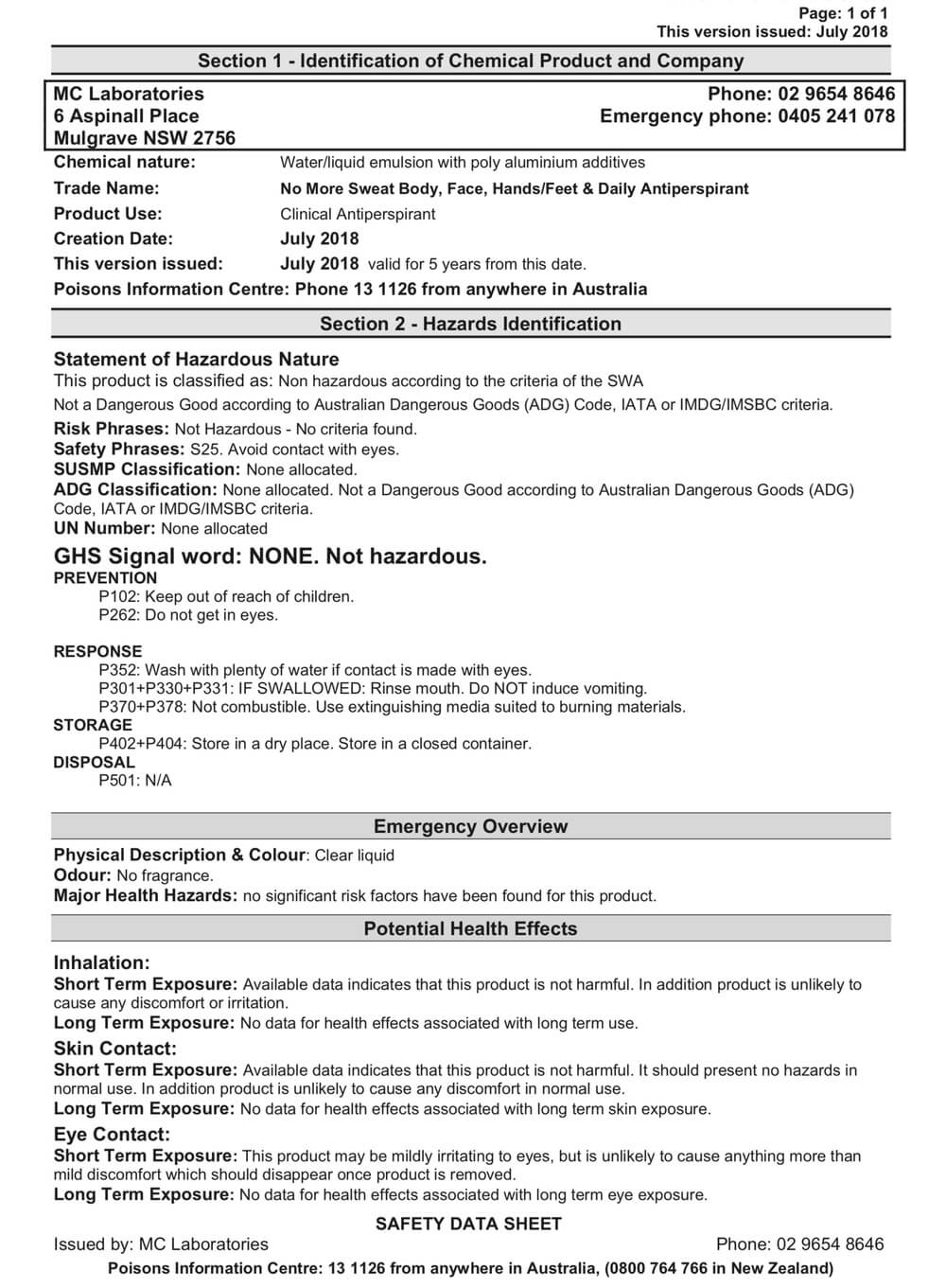About Sweating
There are 2 – 4 million sweat glands distributed all over our bodies. The majority on the soles of the feet, palm of the hands, the forehead, cheek and underarms. Sweat is essential for human survival as it serves as the body’s cooling system, protecting us from over heating . In some people the cooling mechanism is overactive. These people may sweat 4 – 5 times more than necessary. This excessive sweating is a medical condition known as hyperhidrosis.
Sweat glands are activated by nerves. these nerves respond to a variety of stimuli:
Messages from the brain, Hormones, Emotions, Activity or exercise.
3 and 4 million sweat gland covering our bodies and amazingly, we can produce around 11 litres of sweat during a 24hr period. The body produces two types of fluid when we sweat. 1) eccrine, which is a clear, odourless fluid that appears all over our bodies and regulates our body temperature and keeps us cool (Thermoregulation), and 2) apocrine, a more viscous substance that is produced by glands in areas such as the underarm and groin areas. Like eccrine fluids, apocrine fluids are odourless, at least until bacteria on the skin’s surface acts upon it, breaking down enzymes within the fluid and producing the offensive smell that we all associate with sweating.
An estimated 40% of the population will experience some form of excessive sweating or problem odour at some point during their lives. Sweat problems can manifest themselves in specific areas of the body and be caused by many different factors, including age, diet, lifestyle, stress, medication, hormone imbalances, etc. Approximately 3% of the world’s population will suffer with severe excessive sweating, which is clinically identified as ‘Hyperhidrosis’ and can affect any adult, in any area of the body and during any stage of life. Excessive sweating or Hyperhidrosis rarely affects pre-pubescent minors. Axillae (underarms), Palmar (palms of the hands), Plantar (soles of the feet), Cranial-facial (head, face and neck) are all areas commonly affected by excess sweating.
Types of Hyperhidrosis There are two types of hyperhidrosis, understanding the difference is the start of understanding your condition.
Primary focal hyperhidrosis this refers to excessive sweating that is not caused by a medical condition or the side effects of medicines taken by the sufferer.This type of sweating occurs on a specific area of the body, (discribed as “focal” areas) and is usually both the left and right hand side of the body is affected. The most common areas are the hands, feet, under arms, head and face.
Secondary generalised hyperhidrosis refers to excessive sweating caused by a medical condition or the side effects of medicines being consumed by the sufferer. Unlike primary hyperhidrosis, secondary hyperhidrosis is normally larger amounts of sweat in other areas such as back, groin and thighs.
Sufferers often experience sweating during the night while asleep. Secondary normally only starts later in life and is not associated with stress. It is important to see a health care professional to establish what the cause of the sweating could be.
Alzheimer's Myth
A myth that resurfaces every few years and alarms hyperhidrosis sufferers and “normal” sweaters alike – can the aluminum salts in antiperspirants lead to Alzheimer’s? Many of you have asked us this question so we tracked down answers from experts in the field.
Alzheimer’s disease (which is characterized by the progressive breakdown of a person’s mental abilities) has no known single cause. The rumor that aluminum may cause Alzheimer’s can be traced back to a study done in the 1960s which found abnormally high concentrations of aluminum in the brains of some victims of Alzheimer’s disease. However, “After several decades of research,” says the Alzheimer’s Association, “scientists have been unable to replicate the original 1960s studies showing aluminum deposits in a brain affected by Alzheimer’s.”
In a letter written to USA Today in February 2006, the Alzheimer’s Association stated: “The link between aluminum and Alzheimer’s disease has never been conclusively proven… The research community is generally convinced that aluminum is not a key risk factor in developing Alzheimer’s disease. Public health bodies sharing this conviction include the World Health Organization (WHO), the U.S. National Institutes of Health, the U.S. Environmental Protection Agency, and Health Canada.”
To help set consumers’ minds at ease, numerous experts have provided input regarding the Alzheimer-antiperspirant “question”. For example, Dr. Peter Davies, Professor of Alzheimer’s Disease Research at the Albert Einstein College of Medicine has stated, “Most leading researchers in the field of Alzheimer’s disease think it unlikely that aluminum has any role in the development of the disease.”
Drs. William Pendlebury and Paul Solomon, co-directors of the Memory Disorders Clinic of the Southwestern Vermont Medical Center, have said, “At present, aluminum does not appear to play a major role in Alzheimer’s disease, and there is no reason to tell people to avoid minor aluminum exposures (antiperspirants, antacids, aluminum cooking utensils).”
Additionally, Mike Thomas, a chemical engineer and the former Team Leader for Procter & Gamble’s antiperspirant and deodorants line, told the International Hyperhidrosis Society, “There is no scientific or medical evidence to suggest that aluminum in products causes Alzheimer’s disease. The FDA has approved aluminum compounds for use in antiperspirants based on an extensive safety database. The materials in Procter & Gamble’s antiperspirants have undergone extensive safety testing and have been proven safe and effective.” (Procter & Gamble is the world’s largest manufacturer of consumer goods including Secret, Gillette, Old Spice, and Sure antiperspirants in North America.)
Instead of worrying about antiperspirants, the Alzheimer’s Association encourages those who are concerned about Alzheimer’s to be proactive and to make lifestyle changes to promote healthy brain aging and to potentially reduce the risk of Alzheimer’s. You’ll probably notice that a lot of these head-smart tips sound familiar. That’s because what’s good for the body is also good for the brain.








